
The Episcopal Diocese of Washington is a diocese of the Episcopal Church covering Washington, D.C. and nearby counties of Maryland in the United States. With a membership of over 38,000, the diocese is led by the Bishop of Washington, Mariann Budde. It is home to Washington National Cathedral, which is the seat of both the diocesan bishop and the Presiding Bishop of the Episcopal Church.
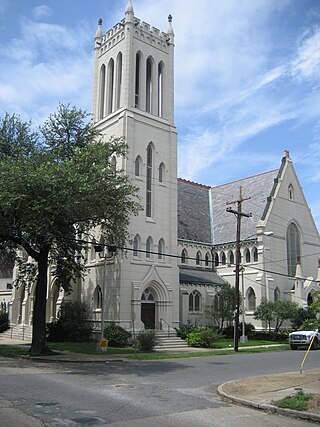
Christ Church Cathedral, located today at 2919 St. Charles Avenue, in New Orleans, Louisiana, in the United States, was the first non-Roman Catholic church founded in the entire Louisiana Purchase territory. It was founded in 1803 as Christ's Church by the Protestant inhabitants of New Orleans, and is today the official seat of the Bishop of Louisiana, in the Episcopal Diocese of Louisiana.

The Cathedral Church of St. Paul is the cathedral church of the Episcopal Diocese of Michigan. In 1824 its congregation formed as the first Episcopal and first Protestant church in the Michigan Territory.

The Episcopal Diocese of Ohio is a diocese of the Episcopal Church in the United States of America comprising the northern 48 counties of the state of Ohio. Established in 1818, it was the first diocese of the Episcopal Church to be established outside the original 13 colonies and presently consists of 95 parishes, with a membership of almost 19,000 individuals. The diocese was contiguous with the state of Ohio, but was divided into two dioceses in 1875, due to the geographical size of the diocese and the poor health of Bishops MacIlvaine and Bedell. The Episcopal Diocese of Ohio, which retained the original name, and the Diocese of Southern Ohio headquartered in Cincinnati. It is one of 15 dioceses that make up the Province of the Midwest.
Trinity Episcopal Church may refer to various buildings and their congregations in the United States:

St. John's Episcopal Church is located at 2600 Church Avenue in the Ohio City neighborhood of Cleveland, Ohio. St. John's is the oldest consecrated building in Cuyahoga county. This stone gothic revival church building was designed by Hezekiah Eldredge and built beginning in 1836 and was completed 1838. Eldridge was probably familiar with John Henry Hopkins' "An Essay on Gothic Architecture", the first book on Gothic ecclesiastical architecture to be published in the United States. St. John's is a good representative of a small group of American churches inspired by Hopkins' book.
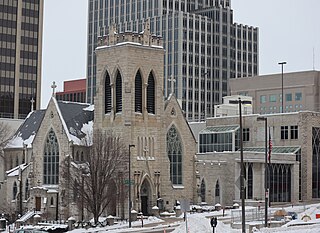
Trinity Cathedral is located in Downtown Omaha, Nebraska. Nebraska's first Episcopal parish, Trinity was established in 1856, and became the state's first Episcopal cathedral in 1872. Designed by noted English architect Henry G. Harrison in 1880, the cathedral was consecrated on November 15, 1883. It was added to the National Register of Historic Places in 1974. Today Trinity Cathedral is considered one of the most beautiful churches in Omaha.
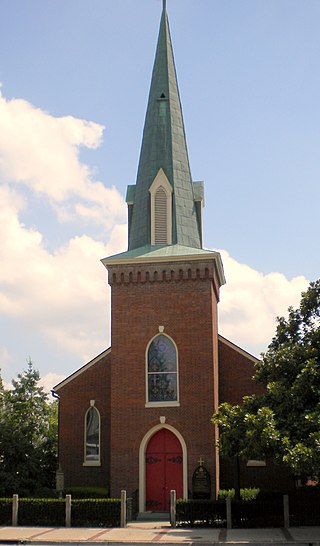
Trinity Episcopal Church in Danville, Kentucky was one of the first churches organized in the Episcopal Diocese of Kentucky. Trinity Church is the oldest in-use church structure in Danville and the oldest continuously used Episcopal church building in the Episcopal Diocese of Lexington as well as the second oldest in Kentucky. It is listed in the National Register of Historic Places.
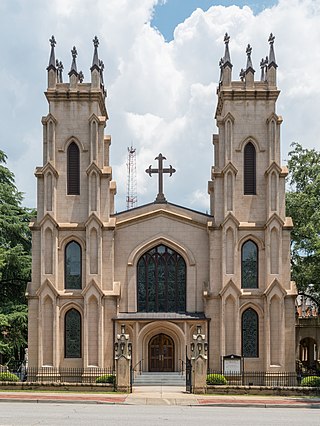
Trinity Episcopal Church, now known as Trinity Episcopal Cathedral, is the first Episcopal and the oldest surviving sanctuary in Columbia, South Carolina. It is a Gothic Revival church that is modeled after York Minster in York, England. It was named to the National Register of Historic Places on February 24, 1971.

Holy Trinity Episcopal Church also known as Holy Trinity Memorial Church is an historic Episcopal church building located at 38 Grand Avenue in the village of Swanton, Franklin County, Vermont. Built in 1876 and expanded in 1909-10, the church facilities include a fine example of the Carpenter Gothic in the older section, and the Late Victorian Gothic Revival in the newer section. The church was listed on the National Register of Historic Places as the Parish of the Holy Trinity in 2001. The church is an active parish in the Episcopal Diocese of Vermont; its current rector is the Rev. Reid D. Farrell.

Trinity Parish Church is a historic church located in the First Hill neighborhood of Seattle, Washington, that was added to the National Register of Historic Places in 1991. It is an Episcopal congregation in the Diocese of Olympia.
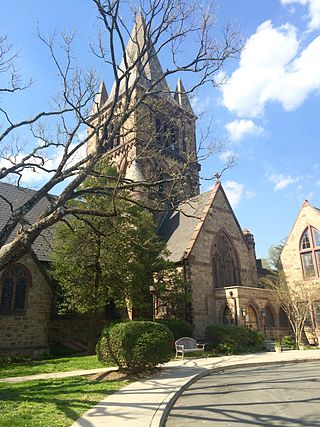
Trinity Church is a historic Episcopal congregation located at 33 Mercer Street in Princeton, New Jersey. It is the largest Episcopal church in New Jersey.
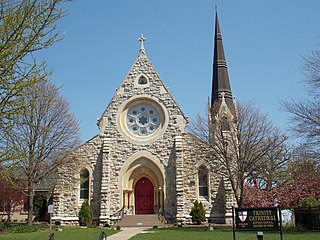
Trinity Episcopal Cathedral, formerly known as Grace Cathedral, is the historic cathedral in the Diocese of Iowa. The cathedral is located on the bluff overlooking Downtown Davenport, Iowa, United States. Completed in 1873, Trinity is one of the oldest cathedrals in the Episcopal Church in the United States. It was individually listed on the National Register of Historic Places in 1974. In 1983 the cathedral was included as a contributing property in the College Square Historic District, which is also listed on the National Register.

St. Paul's Episcopal Cathedral, is located in downtown Des Moines, Iowa, United States. It is the cathedral church of the Episcopal Diocese of Iowa. The building was listed on the National Register of Historic Places as St. Paul's Episcopal Church.

Trinity Episcopal Church is a parish church in the Diocese of Iowa. The church is located in Muscatine, Iowa, United States. It was individually listed on the National Register of Historic Places in 1974. In 2006 it was included as a contributing property in the Downtown Commercial Historic District.
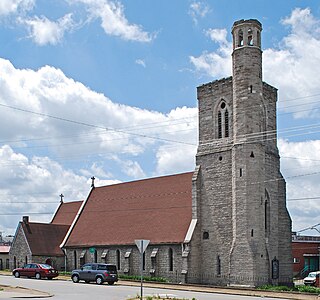
Holy Trinity Church is a historic Episcopal church at 615 6th Avenue South in Nashville, Tennessee, currently a parish of the Episcopal Diocese of Tennessee. The congregation was formed in 1849 as a mission of the nearby Christ Church Episcopal, attained parish status in 1851, and grew to around fifty members per service by the beginning of the American Civil War. During the war, the church was occupied by Federal troops and was badly damaged. After repairs, services continued and a new mission was opened on Wharf Avenue, which catered to the African American population of Nashville and soon overtook Holy Trinity in membership. After Holy Trinity lost parish status in 1895, the two missions merged and continued to serve the African American community of Nashville. Its congregation was largely made up of faculty and students from nearby Fisk University and other educational institutions. The mission reattained parish status in 1962, and the current rector is Bill Dennler.
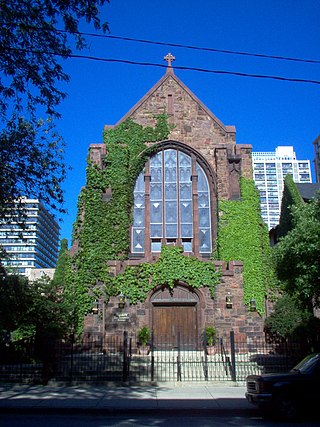
The Episcopal Church of the Atonement and Parish House is a historic church building at 5751 North Kenmore Avenue in Chicago, Illinois. The Gothic Revival building was constructed in 1889 and added to the National Register of Historic Places in 2009.

Gethsemane Episcopal Cathedral is an Episcopal cathedral in Fargo, North Dakota, United States. It is the seat of the Diocese of North Dakota.

The Cathedral Church of the Nativity is an Episcopal cathedral in Bethlehem, Pennsylvania. It is the seat of the Diocese of Bethlehem. In 1988 it was listed as a contributing property in the Fountain Hill Historic District on the National Register of Historic Places.

Christ Church, also known as Christ Episcopal Church, is a Christian house of worship located on the corner of Church Street and Main Street in Newton, New Jersey. It is a parish overseen by the Episcopal Diocese of Newark, a diocese of the Episcopal Church in the United States of America. The congregation first met on 28 December 1769 and was granted a charter by New Jersey's last Royal Governor William Franklin on behalf of Britain's King George III. Christ Church is the oldest church in Newton and the third oldest parish in the Diocese of Newark.























